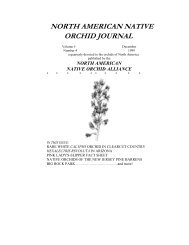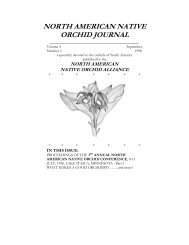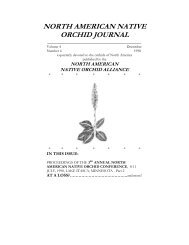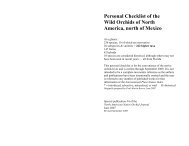north american native orchid journal - at The Culture Sheet
north american native orchid journal - at The Culture Sheet
north american native orchid journal - at The Culture Sheet
Create successful ePaper yourself
Turn your PDF publications into a flip-book with our unique Google optimized e-Paper software.
Pelch<strong>at</strong>: SPIRANTHES PARKSII CORRELL – NAVASOTA LADIES’-TRESSES<br />
leading into woodlands and adjacent to the edge of woods along<br />
hiking trails the most plants were found within the woods on the<br />
banks of the n<strong>at</strong>ural drainage ditches. This observ<strong>at</strong>ion confirms<br />
th<strong>at</strong> Spiranthes parksii does not typically inhabit open areas or areas<br />
disturbed by man. Today S. parksii is well documented growing in<br />
the Navasota region and one especially good and accessible<br />
(because it is not priv<strong>at</strong>e property) loc<strong>at</strong>ion is Lick Creek Park<br />
loc<strong>at</strong>ed in College St<strong>at</strong>ion. I have observed it growing in this park<br />
along the banks of drainage streams and <strong>at</strong> the mouth of these<br />
drainage areas leading from the open grassy areas of the Post Oak<br />
Savannah. I have also observed it growing on the margins of the<br />
wooded forest near drainage ditches where hiking trails have been<br />
formed. This habit<strong>at</strong> lies in close proximity to Texas A & M<br />
University and Dr. Hugh Wilson, from the University, undertook<br />
a detailed study of S. parksii. Unfortun<strong>at</strong>ely this study was<br />
brought to an abrupt halt by the expansion of a recre<strong>at</strong>ional bike<br />
p<strong>at</strong>h.<br />
Morphology<br />
<strong>The</strong> genus Spiranthes is highly variable from the<br />
morphological point of view and, <strong>at</strong> times, it is difficult to<br />
differenti<strong>at</strong>e between species in the field. <strong>The</strong> problem of field<br />
identific<strong>at</strong>ion is compounded for the species S. parksii because it<br />
blooms <strong>at</strong> the same time and in the same range as two other<br />
species, S. cernua (L.) L.C. Richard and S. lacera Raf. var. gracilis<br />
(Bigel.) Luer, and is found in similar habit<strong>at</strong> as S. cernua mixed in<br />
with blooming popul<strong>at</strong>ions. However, once one establishes a<br />
p<strong>at</strong>tern of identific<strong>at</strong>ion there is no mistaking S. parksii for either<br />
S. cernua or S. lacera var. gracilis, though there are some plants th<strong>at</strong><br />
seem to be intermedi<strong>at</strong>e between S. parksii and S. cernua and these<br />
are not easily resolved in the field. While photographing these<br />
plants with a 105mm macro lens many of the characters described<br />
by Correll (Correll 1947 and 1950) are apparent. <strong>The</strong> line drawing<br />
by G. Dillon th<strong>at</strong> accompanies Correll’s description is extremely<br />
accur<strong>at</strong>e, and looks as if it was drawn form a live specimen r<strong>at</strong>her<br />
then an herbarium sheet.<br />
28













